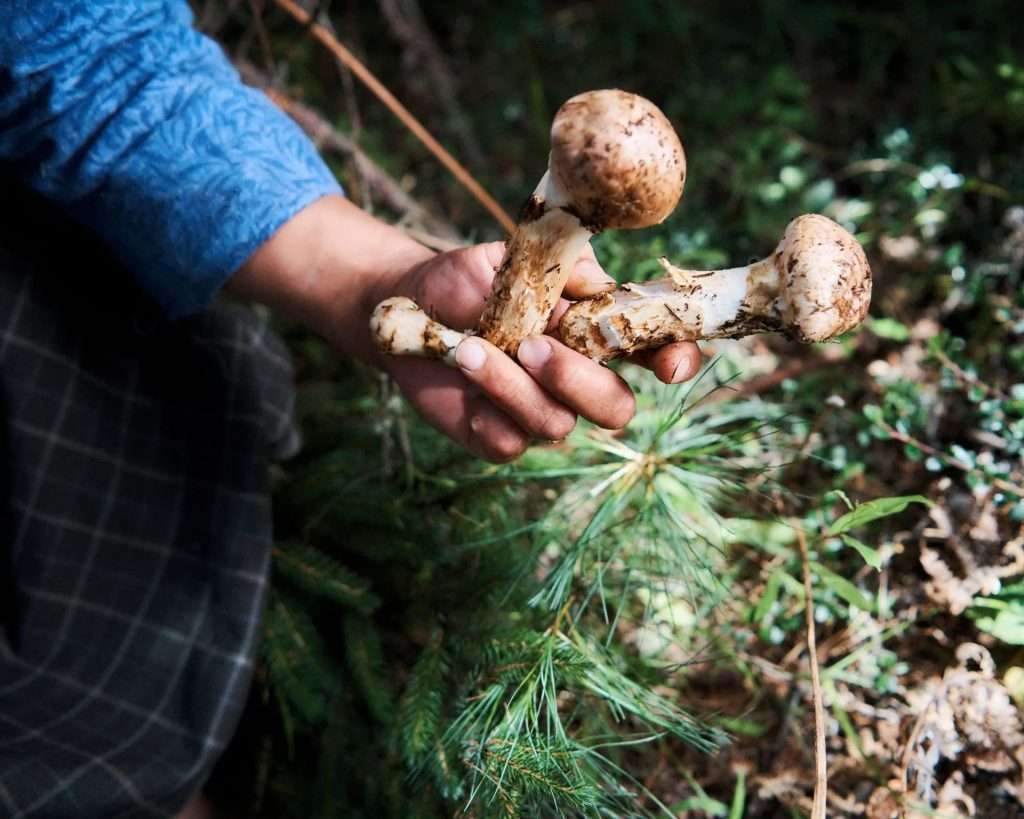Bhutan is renowned for its rich culture, stunning flora and fauna, awe-inspiring architecture, and unparalleled hospitality. Among its treasures is a deep-rooted love for mushrooms. Did you know that Bhutan boasts over 400 varieties of mushrooms?
The Bhutanese hold a special affinity for mushrooms, often embarking on multi-day forest camps during harvest seasons of their favorite varieties. These versatile fungi are not only cherished in local diets but also play a crucial role in traditional medicines. You can spot villagers selling chanterelles, shiitake, and coral mushrooms in bustling markets and along roadside stalls. In winter, when fresh produce is scarce, dried mushrooms collected during summer become a staple.
Mushrooms in Bhutan are broadly classified into categories like edible, of unknown edibility, poisonous, and inedible, reflecting the deep knowledge and respect for these fungal treasures.
One of the most sought-after mushrooms in Bhutan is the Tricholoma Matsutake, also known as Sangay Shamu. Its popularity surged thanks to an intriguing tale: Aum Kuchum was the first to discover Matsutake in Bhutan while selling mushrooms at Thimphu’s vegetable market. A Japanese guest noticed its resemblance to the prized Japanese Matsutake, sparking local interest. Soon, villagers began harvesting Matsutake commercially. Originally dubbed Po Shamu for its phallic shape, it was renamed Sangay Shamu or Buddha’s mushroom. Harvested from July to September, it is boxed and flown to Japan, delighting fungi enthusiasts there.
Bhutanese cuisine often features mushrooms cooked with chili and cheese, with one popular dish being Shamu Datshi. This simple yet savory dish combines Matsutake mushrooms, vegetables, a touch of salt, and cheese. The mushrooms impart robust flavors to the soup, while the cheese adds a creamy texture.
Sangay Shamu mushrooms are indigenous to the forests of Ura Valley in Bumthang and Genekha in Thimphu, typically found growing in clusters at the base of pine trees. These areas are renowned for their abundant mushroom harvests. During seasons when Sangay Shamu is scarce in autumn and winter, Bhutanese cuisine adapts by using other varieties such as gypsy, shiitake, and oyster mushrooms.
Matsutake mushrooms are increasingly rare and cannot be cultivated on a large scale domestically. Japanese researchers have developed a related variety called Baka Matsutake, which closely mimics the aroma of wild Matsutake. However, the distinctive appearance and complex, earthy-spicy flavors of Sangay Shamu remain unique and cannot be replicated in a laboratory.
Outside of Sangay Shamu season, dishes substitute other mushrooms like gypsy, shiitake, and oyster mushrooms, ensuring that Bhutanese cuisine maintains its rich culinary traditions year-round.
MATSUTAKE MUSHROOM FESTIVAL
Genekha village, just a short 45-minute drive from Thimphu, comes alive during the second week of August with its annual Mushroom Festival. Meanwhile, Ura village in Bumthang celebrates the Matsutake Mushroom Festival annually during the third or fourth week of August. These festivals aim to promote awareness about sustainable mushroom harvesting practices and celebrate the organic flavors of nature.
The festivals feature a variety of engaging activities, including guided mushroom picking expeditions, savoring delectable mushroom delicacies, cultural performances by local residents and schoolchildren, and traditional sports events. Once annually during the harvesting season, villagers traverse the valley to gather Sangay Shamu mushrooms. This initiative, sanctioned by the Bhutanese government, supports the empowerment of communities in these two villages through legal mushroom harvesting.
CORDYCEPS SINENSIS, THE SUPER MUSHROOMS OF BHUTAN
In addition to the Matsutake Mushroom, Cordyceps Sinensis is renowned for its medicinal properties. These parasitic super mushrooms are harvested by foragers from the heads of caterpillars. The fungus invades the caterpillar’s body, eventually leading to its demise as it consumes the insect from within. Cordyceps Sinensis is particularly prized and sought after due to its rarity—it grows exclusively at high altitudes—and the challenges involved in its harvesting.
Research indicates that Cordyceps can help in preventing hyperglycemia (diabetes type 1 or 2) and enhance insulin sensitivity. Additionally, they are known to lower the risk of dementia and possess antidepressant properties. These beneficial fungi are readily available in local stores and can make a wonderful gift for your dear ones.

